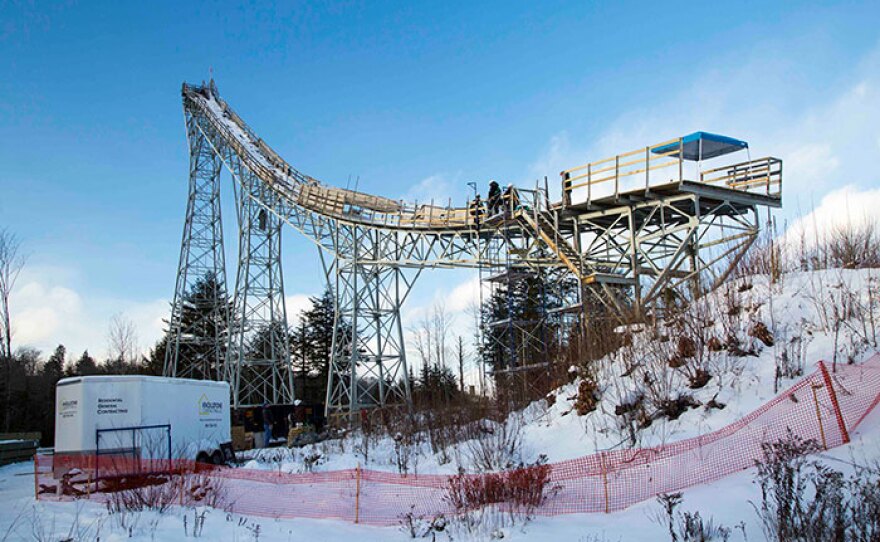A towering landmark in New Hampshire's North Country has been brought back to life.
After falling into disrepair, the 171-foot-tall Nansen Ski Jump in Milan was restored over the winter, and will soon host its first jump in more than three decades.
Located just north of Berlin along Route 16, the jump hosted Olympic Trials in 1938, and went on to host four national ski jumping championships.
Ben Wilson is director of the bureau of historic sites for New Hampshire State Parks. He joined NHPR’s Morning Edition to talk about the restoration project.
A lot of listeners are probably hearing about the Nansen Ski Jump for the first time. What can you tell us about it?

The jump has a really colorful history. It was the brainchild of Alf Halvorson, who had a history as one of the ski coaches for the first Winter Olympics. In 1932, he takes three folks from the Nansen Ski Club over to Lake Placid for a ski jumping competition and gets the idea to bring the Olympics actually to Berlin. That’s where the ski jump gets its first start. Construction on the jump was started in 1935 and completed by 1937.
Let’s talk about how big this thing is, because it really is a colossus on the skyline.
Absolutely. It stands like a dinosaur on top of the hill. It is 171 feet tall. It has a 310-foot run out, and then 390 feet or so of a landing. It was the largest ski jump east of the Mississippi at the time.
When did the jump fall into disrepair?
In the 1970s, there was an accident. A skier was paralyzed, and it sort of put a dark veil over the jump. They had the last jump in 1985. The site was closed down. It literally has languished for about 30 years.
Where did the idea of restoring it come from?
Every so often, I’d get a call from a local person asking what are we going to do with this iconic structure. It has so much history, it means so much to the culture and to the people of the area. We’ve got to do something about it, but there wouldn’t be a follow up. So about three years ago I got a call, and I said OK, let’s have a meeting. About 10 or 12 people showed up. There was a lot of energy; there were a lot of ideas, things we thought we could actually accomplish.
A year and a half ago, there was a local news article about the jump and about what we were doing. It went out on the AP, and Red Bull Media actually picked up the story out in Los Angeles. They had a ski jumper they sponsored. They said she’s trying to rebuild her career after an ACL tear, you guys are repairing the jump, what a great parallel storyline. Let’s try to do something.
So did they bring some funding you needed to complete the project?

They did. They really moved our timeline up in a big way because of the funding because of the attention they were going to bring to it. Red Bull, when all is said and done, will have about $75,000 investment in the structure alone. It’s not something they often do. And the state will bring about $150,000.
What did it take to restore this structure?
Our restoration of the site, the majority of it has been the landscape. Clearing all the trees from the site and redecking the jump. We started that project with a local company, Knollstone Contractors in Bow, in late November. And to think they’d be on top of this 171-foot structure in the beginning of December through January in below-zero temperatures is just amazing. That hard work was incredible to watch and was certainly a feat. I have to be honest that I didn’t think it was going to happen this winter, but they were able to pull it off.
You have this Red Bull event coming up, this big jump. Tell us about that.
Sarah Hendrickson, who is an Olympic ski jumper, two-time World Cup champion, she is going to do a jump, maybe more than one jump, and Red Bull is filming this as part of a documentary film. We’ll have about two weeks at the end of the month to get the jump prepared. Sarah will be flying back from World Cup competition in Europe somewhere around March 1, so somewhere around March 1 and March 5, her jump will take place.
What are the plans for the Nansen Ski Jump after that?

This is really the kick off. Sarah Hendrickson’s jump is really going to shed a lot of light on the site. Right now, we’re working with the Department of Historical Resources in doing a national register application. We’ve done a lot of research into the history of the site. We feel it has national landmark status. We’re going to be basically turning it into a passive use historic site where people can pull in, there will be some picnic tables, and they’ll have an opportunity to read large, interpretive panels on the site to learn about the history and the culture of the area. They will be able to hike the hill. We have an access road that goes up the backside that takes you right to the jump, so people will be able to drive right to the jump itself. Just the way our fire towers around the state are really popular, we’re going to allow people to climb the stairs up to the take-off area of the jump itself, so people can get an idea of what it looked like launching off of that jump.
What’s been the reaction around the community?
You would think we had attracted General Electric’s international headquarters to Berlin. It has really sparked a lot of emotions in the area. People are so excited that this site is being given the due that it really deserves. It’s one of the greatest feel-good restoration projects I’ve been involved in.













